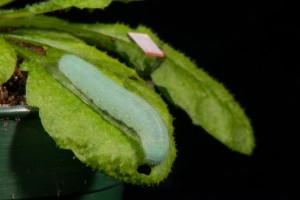Experiments show chewing vibrations, but not wind or insect song, cause response
As the cabbage butterfly caterpillar takes one crescent-shaped bite at a time from the edge of a leaf, it doesn’t go unnoticed.
This tiny Arabidopsis mustard plant hears its predator loud and clear as chewing vibrations reverberate through leaves and stems, and it reacts with chemical defenses. Plants have long been known to detect sound, but why they have this ability has remained a mystery.
University of Missouri experiments mark the first time scientists have shown that a plant responds to an ecologically relevant sound in its environment.
“What is surprising and cool is that these plants only create defense responses to feeding vibrations and not to wind or other vibrations in the same frequency as the chewing caterpillar,” said Heidi Appel, an investigator at MU’s Bond Life Sciences Center and senior research scientist in the Division of Plant Sciences in the College of Agriculture, Food and Natural Resources.

Appel partnered with Rex Cocroft, an MU animal communication expert who studies how plant-feeding insects produce and detect vibrations traveling through their host plants.
“It is an ideal collaboration, that grew out of conversations between two people working in different fields that turned out to have an important area of overlap,” said Cocroft, a professor of Biological Sciences in MU’s College of Arts and Science. “At one point we began to wonder whether plants might be able to monitor the mechanical vibrations produced by their herbivores.”
While Appel focused on quantifying “how plants care and in what ways,” Cocroft worked to capture inaudible caterpillar chewing vibrations, analyze them and play them back to plants in experiments that mimic the acoustic signature of insect feeding, but without any other cues such as leaf damage.
Cocroft used specialized lasers to listen to and record what the plant hears.
“Most methods of detecting vibrations use a contact microphone, but that wasn’t possible with these tiny leaves because the weight of the sensor would change the signal completely,” said Cocroft.

The laser beam reflects off a small piece of reflective tape on the leaf’s surface to measure its deflection, minimizing contact with the plant. The laser’s output can also be played back through an audio speaker, allowing human ears to hear the vibrations produced by the caterpillar.
Moved by the sound
Recording the sound is just the start.
You can’t put headphones on a leaf, so tiny piezoelectric actuators – essentially a tiny speaker that plays back vibrations instead of airborne sound – is required.
“It’s a delicate process to vibrate leaves the way a caterpillar does while feeding, because the leaf surface is only vibrated up and down by about 1/10,000 of an inch,” Cocroft said. “But we can attach an actuator to the leaf with wax and very precisely play back a segment of caterpillar feeding to recreate a typical 2-hour feeding session.”
Appel and Cocroft tested whether these chewing sounds could create more chemical defenses in the plants and whether these feeding recordings primed defenses when played before an actual caterpillar ate part of a leaf.
“We looked at glucosinolates that make mustards spicy and have anticancer properties and anthocyanins that give red wine its color and provide some of the health benefits to chocolate,” Appel said. “When the levels of these are higher, the insects walk away or just don’t start feeding.”
The researchers played 2 hours of silence to some Arabidopsis plants and 2 hours of caterpillar-chewing noises to others. They then chose three leaves around the plant, and allowed caterpillars to eat about a third of each leaf. After giving the plants 24 to 48 hours to respond to the caterpillar attack, they harvested the leaves for chemical analysis.
When they found higher levels of glucosinolates in the plants that were exposed to chewing vibrations, they knew they were on the right track.
A similar second experiment went further, testing whether the plants would simply respond to any vibration, or whether their response was specific to chewing vibrations. In this case Appel analyzed anthocyanins, which again were elevated – but only when plants had been exposed to chewing vibrations but not to vibrations created by wind or the sounds of a non-harmful insect.
Past echoes and future promise
While the past is littered with suggestions that people talk to their plants, Appel and Cocroft hope their work is shifting the focus on plant acoustics towards a better understanding of why plants can detect and respond to vibrations.
“The field is somewhat haunted by its history of playing music to plants. That sort of stimulus is so divorced from the natural ecology of plants that it’s very difficult to interpret any plant responses,” Cocroft said. “We’re trying to think about the plant’s acoustical environment and what it might be listening for, then use those vibrational sounds to figure out what makes a difference.”
The National Science Foundation seems to agree with the merit of their endeavor, awarding a grant to extend this project.
The next step includes looking at how other types of plants respond to insect predator sounds and pinpointing precisely what features of the sounds trigger the change in plant defenses.
These questions aim to further basic research understanding of how plants know what’s going on to respond appropriately to their environment. This could one day lead to ways to create better plants.
“Once you understand these things you can mess around with it in plant breeding through conventional methods or biotech approaches to modify plants so they are more responsive in the ways you want to make them more resistant against pests,” Appel said. “That’s the practical application one day.”
This research was published online in the journal Oecologia July 1, 2014 and will appear in print in its August issue.

